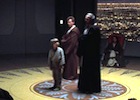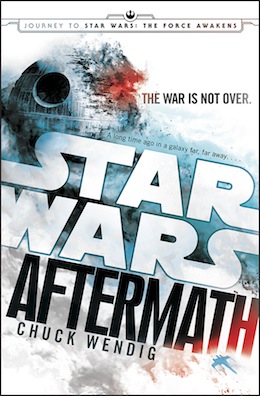When Disney bought LucasArts, with plans for a proper sequel to Return of the Jedi, they had a major decision to make. See, over the past forty or so years LucasArts had solicited a sprawling collection of novels, comics, games and other media, which was called the Expanded Universe (EU). A lot of EU material took place after Jedi, and was probably solicited—and written—with the understanding that no film sequels would actually be made. And if they were? Well, that could be dealt with later on. But now that Disney had possession of the property, the question of what to do with the EU could no longer be put off. People wondered: would they adapt one of the more popular works of the EU, or start afresh?
The answer, as we all presumably know by now, was “start afresh.” And in order to do so, Disney decided to kill off the EU.
This, as you can imagine, did not go down well with everyone. After all, a hardcore of Star Wars fans had spent that forty-year period diligently reading every new release and absorbing as much tangential knowledge about the Star Wars universe as possible. Some EU products were also good: Timothy Zahn’s Thrawn Trilogy brought a number of childhood fans back into the fold as teenagers and adults, while Knights of the Old Republic contains not only one of the best Star Wars stories ever told, but one of the best in the gaming medium. Now Disney had stripped these cherished stories of their canonical status. While some fans said “meh, they do this in comics every few years,” others felt betrayed.
Some of those fans have apparently decided to “take revenge” on the Chuck Wendig’s Disney-certified novel, Star Wars: Aftermath, through a deluge of one-star reviews left on its Amazon page. Sure there are other reasons fans dislike the novel (some just don’t like the writing style, while others are apparently upset that one character is gay and the fact that this is mentioned maybe twice in the novel is an intolerable act of…something). But many of those one-star reviews appear to have been left to protest Disney killing off the EU. The protest is unlikely to affect the high-level marketing decisions of a multibillion-dollar, multinational corporation for which licensed novel sales represent a drop in the proverbial ocean of revenue. But it is a coping mechanism, and a way to communicate that said high-level marketing decisions are not cost-free.

The transmogrification of Star Wars: Aftermath into a focus for broader protests against the Disney continuum is also deeply unfair to the book itself, which should be judged on its own merits. Granted, some critics leaving one-star reviews have done just that. But a cursory perusal of the Amazon reviews demonstrates that many who felt the need to comment have neither read the book nor intend to do so.
As political controversies generally do, the sturm und drang over Star Wars: Aftermath piqued my curiosity. I decided to see for myself what all the fuss was about.
WARNING: some spoilers follow.
Aftermath takes place not long after the destruction of the second Death Star, at a time when the New Republic is establishing itself as a state but has not quite finished off the Galactic Empire. Fighting rages in many parts of the galaxy, including within the Empire itself. Facing this crisis, several of its most powerful figures—Admiral Rae Sloane, Moff Valco Pandion, General Jylia Shale, former advisor to Palpatine, Yupe Tashu and financier Arsin Crassus—convene a conference at the palace of a former vassal, the Satrap of Akiva. The purpose of the conference is to decide on a strategy: fight, surrender or effect a strategic retreat. Akiva is chosen to host the conference for unclear reasons, though likely because it is not under the sway of any one Imperial faction. However, it is also an unincorporated tributary planet, and as such isn’t actually under the military control of the Empire. From the get go, this decision appears likely to bite them in the ass.
The inevitable ass-biting comes from several figures who all convene on Akiva at the exact moment of the conference. The first of these is Wedge Antilles, ace pilot, fan favorite and EU mainstay. Then there’s Norra Wexley, another hotshot rebel pilot and a native Akivan who has come home to get her son, Temen, who is now working as a gun merchant and has run afoul of the local mob; Jas, a bounty hunter with a contract for Crassus, who stumbles upon the conference and sees an opportunity for an even bigger score; and Sinjir Rath Velus, a former Imperial Loyalty Officer (i.e. commissar) who deserted on Endor and is now trying to drink himself into oblivion. I’ll leave you to guess whether this scrappy band of ragtag heroes carries the day or not.
As a work of literature, Star Wars: Aftermath is decidedly uneven. Wendig generally does a good job with the action scenes, and the first half of the book moves at a fast clip—propelled by the coming together of its various protagonists and the mystery of what will become of the Empire. I was thoroughly engrossed early on, and there are some really memorable scenes—like when Sinjir stands up to a pair of brutish Imperial officers who are throwing their weight around in his favorite watering hole. But there are also missteps. The conference is tedious, as are its attendees (save Sloane). And Temen, the “sassy teenage genius who likes to wing it and doesn’t need his Mom telling him what to do” is as irritating as he is cliché. Worse, the book has a natural ending about two-thirds of the way through, but keeps going—riding a plot twist that doesn’t work an anticlimactic finish. Think Lost after Jack and Kate escape the island.
The politics of Aftermath—that is, the politics *within* Aftermath, not the politics *of* Aftermath—offer a great deal of promise, and Wendig deserves praise for embracing the messiness that would inevitably follow the Rebel victory at Endor and consequent collapse of the autocratic, centralizing Empire. At the end of each chapter there is an interlude—a short vignette about what’s happening in the galaxy, and which show the destruction wrought both by the Empire and the subsequent war to unseat it. Some of these are gripping, my favorite being the tale of a slave revolt against the organized crime syndicates that the Empire relied on to keep the Outer Rim worlds in line. This vignette also had the ancillary effect of laying bare the fact that the Empire is not only a totalitarian entity, but a human supremacist one at that. I’d never really thought about that, but in retrospect it’s an obvious element of everything from A New Hope on.

Unfortunately, there is only so much Wendig can say without transgressing the central assumptions of the Star Wars universe. As such, the interludes rarely stray from the simplistic “rebels good/Empire bad” formula established in the films. That setup is defensible in the context of the films, which are constructed like the foundational myths of an ancient civilization. On the other hand, to me at least, novels are the perfect medium for transcending that construction and incorporating lessons from human history into the expanded narrative. As Aliette de Bodard recently explained, empires don’t rule simply (or even primarily) by force; rather, they and their often arbitrary rules are internalized by their subjects—something that makes them difficult to dislodge.
Empires also tend to benefit favored segments of the population: those at the center of power and “favored elites” in the periphery, individuals and groups who are consequently reluctant to see their privileges disappear. And civil wars—such as the one fought in that Galaxy far, far away—rarely end with anyone’s moral superiority intact. Rebels and revolutionaries, it turns out, are likely to exact bloody revenge on their former oppressors, while the oppressors and their favored elites use indiscriminate violence to hold on to whatever power they have left.
Note that this is not a moral equivalence argument—often there is nothing of the sort. For example, land seizures and violence against Dutch settlers in the early days of Indonesian independence do not equate, in moral-ethical terms, to more than 300 years of systematized oppression by the Dutch colonial regime. But political upheavals, and especially militarized ones, are inherently messy and ambiguous things, with long-term and often deleterious consequences—in the Indonesian case, certainly, and in nearly every other too.
It would have been neat if Wendig had explored that kind of thing to a greater degree than he did, to really get the reader thinking about what life would really be like after Endor. There are hints that Wendig may have wanted to go that route—the riot on Akiva being one example. But punches are pulled, and I’m guessing that this is a limitation imposed by writing licensed fiction. The property is not yours, and so you just don’t get to do whatever you want with it.
In the end, I found Star Wars: Aftermath to be both a promising and frustrating book. It has undeniable exuberance: I certainly enjoyed the act of reading the novel more than any in the Star Wars universe since I finished the Thrawn trilogy. But tropey characters, an unnecessary twist to tack more story past the natural ending and pulled punches on the political ambiguity front (the last of which I do not blame Wendig for) weigh it down.
The G is founder and co-editor of the group blog ‘nerds of a feather, flock together’, which covers SF/F and crime fiction, comics, cult films and video games. He moonlights as an academic.










